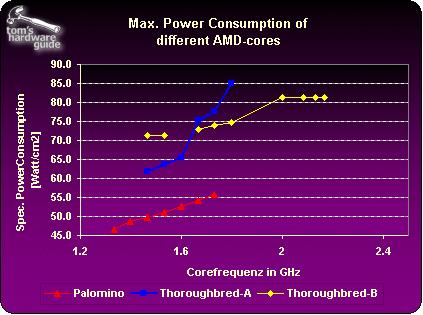A Comparison of 34 Coolers for the AMD Athlon XP
34 Alternatives To The AMD Boxed Cooler
At first glance, the development of a powerful cooler solution for the Athlon-XP has become easier: with the launch of the Thoroughbred B core in August 2002, AMD increased the DIE surface area by five percent to 84 square millimeters. In addition, the theoretical maximum power dissipation of the current top model, the Athlon XP 2700+, boasting 68.3 Watts, is practically identical to that of the Athlon XP 2200+ with a Thoroughbred A core (67.9 Watts). The specific power dissipation (based on DIE area) has, as a result, also dropped by approximately five percent.
Spec. Power dissipation of the various different AMD cores.
An inspection of the datasheets of the two processors and the "AMD Thermal, Mechanical, and Chassis Cooling Design Guide" shows, however, that the maximum permissible DIE temperature for the Athlon XP 2200+ upwards may only be 85° Celsius, rather than 90° Celsius. AMD therefore recommends that only copper be used for the contact surface between the die and the cooler. Compared to aluminum, copper displays a thermal conductivity that is up to fifty percent higher, and thus caters to a more rapid conduction of heat. However, as copper is significantly more expensive than aluminum, coolers constructed in this way are, of course, not cheap.
Those who chose not to take the PIB option (PIB=Processor in a Box), whereby AMD offers a processor and an appropriate cooler when it comes to buying a processor, will have to look for a suitable cooler themselves.
This was reason enough for THG to subject the latest coolers on the market to a closer inspection. We asked the manufacturers to send us a model capable of meeting the increased demands of an Athlon XP CPU with a Thoroughbred B core. Furthermore, we left it up to the manufacturers to send us a particularly powerful and acoustically inconspicuous model.
Get Tom's Hardware's best news and in-depth reviews, straight to your inbox.
Current page: 34 Alternatives To The AMD Boxed Cooler
Next Page Theory: The Optimum Cooler
